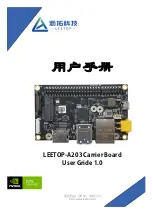
2
3
click
BOARDS
™
www.mikroe.com
2. Soldering the headers
3. Plugging the board in
Once you have soldered the headers your
board is ready to be placed into the desired
mikroBUS
™
socket. Make sure to align the cut
in the lower-right part of the board with the
markings on the silkscreen at the mikroBUS
™
socket. If all the pins are aligned
correctly, push the board all the
way into the socket.
Turn the board upward again. Make sure
to align the headers so that they are
perpendicular to the board, then solder the
pins carefully.
Turn the board upside down so that
the bottom side is facing you upwards.
Place shorter pins of the header into the
appropriate soldering pads.
Before using your click board
™
, make sure
to solder 1x8 male headers to both left and
right side of the board. Two 1x8 male headers
are included with the board in the package.
4. Essential features
The ISL29125 IC on Color 2 click has two
selectable measurement ranges and two
selectable, corresponding output resolutions.
When using the board in the narrower 5.7
m lux-375 lux range, a 12-bit resolution is
optimal. The wider 0.152 to 10,000 lux range
calls for a 16-bit output. The sensor also
incorporates an IR blocking filter, allowing
Color 2 click to work even under a dark glass
cover. The integrated ADC also rejects 50Hz
and 60Hz flicker from artificial light sources,
further increasing the reliability of the sensor.
1
Color 2 click carries the
ISL29125 RGB
color light sensor from Intersil. The
photodiode detects red, green and blue in
a variety of lighting conditions, outputting
16-bit resolution data in a 5.7m lux-
10,000 lux measuring range. Color 2 click
communicates with the target MCU through
the mikroBUS
™
I2C interface (SCL and SDA
pins). A programmable interrupt pin is also
available. The board is designed to use a 3.3V
power supply only.
COLOR 2
click
1. Introduction
COLOR 2 Manual v100
0100000089651













